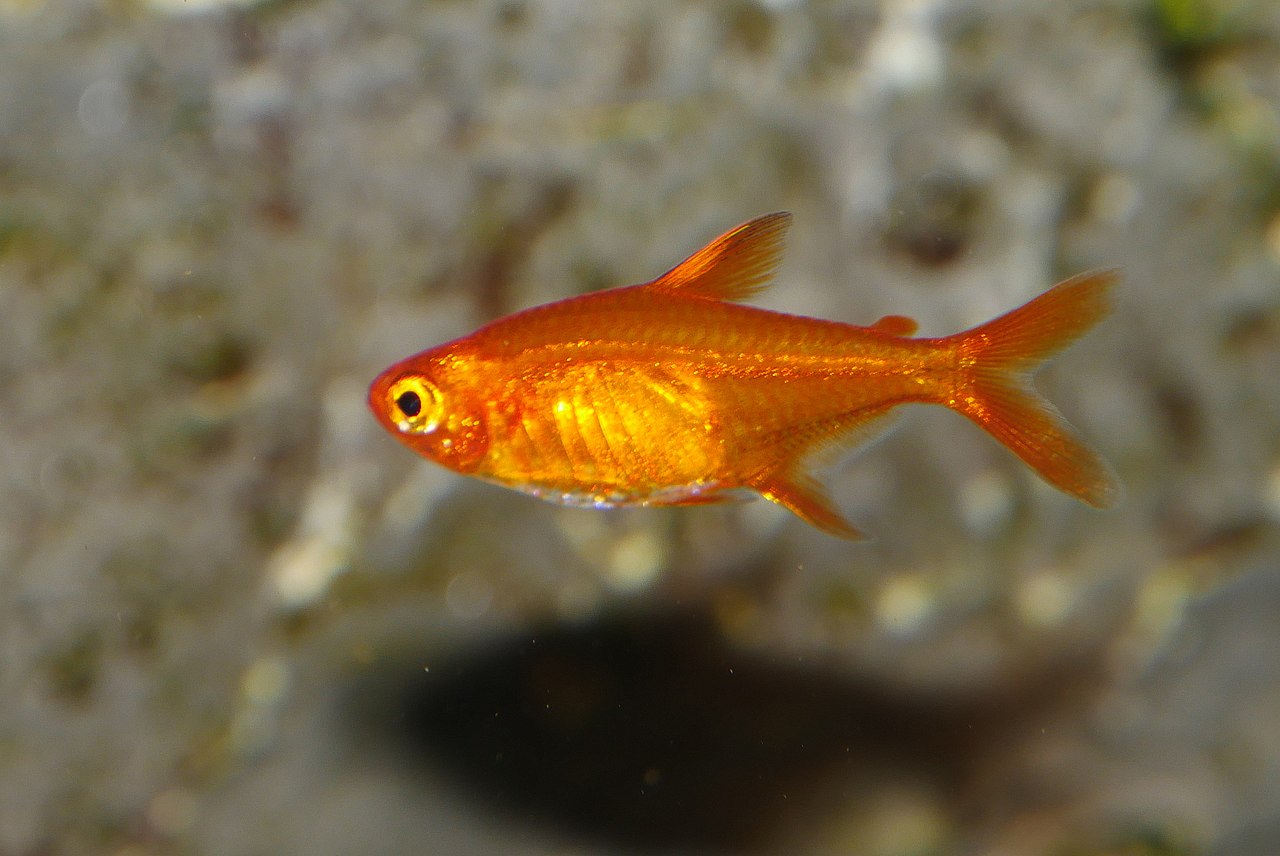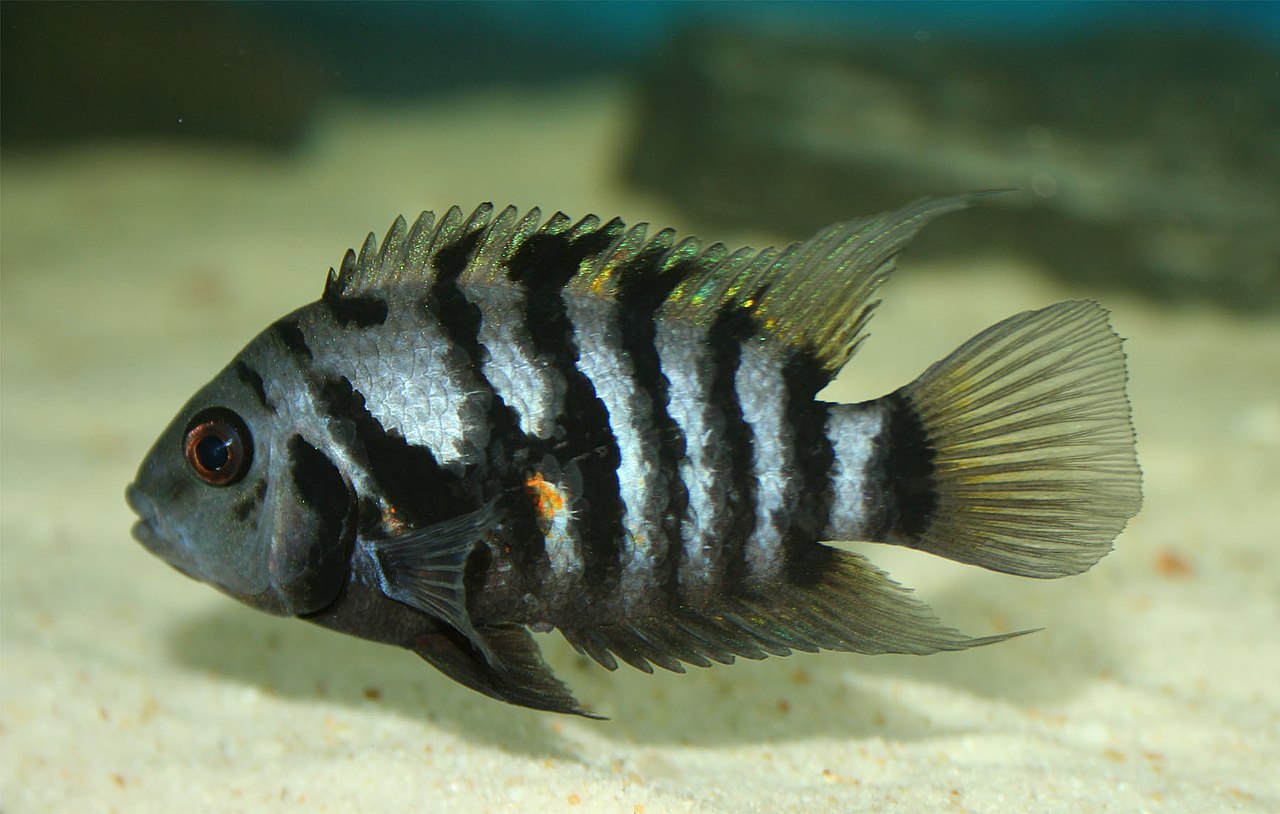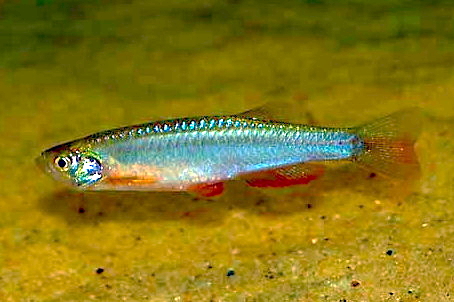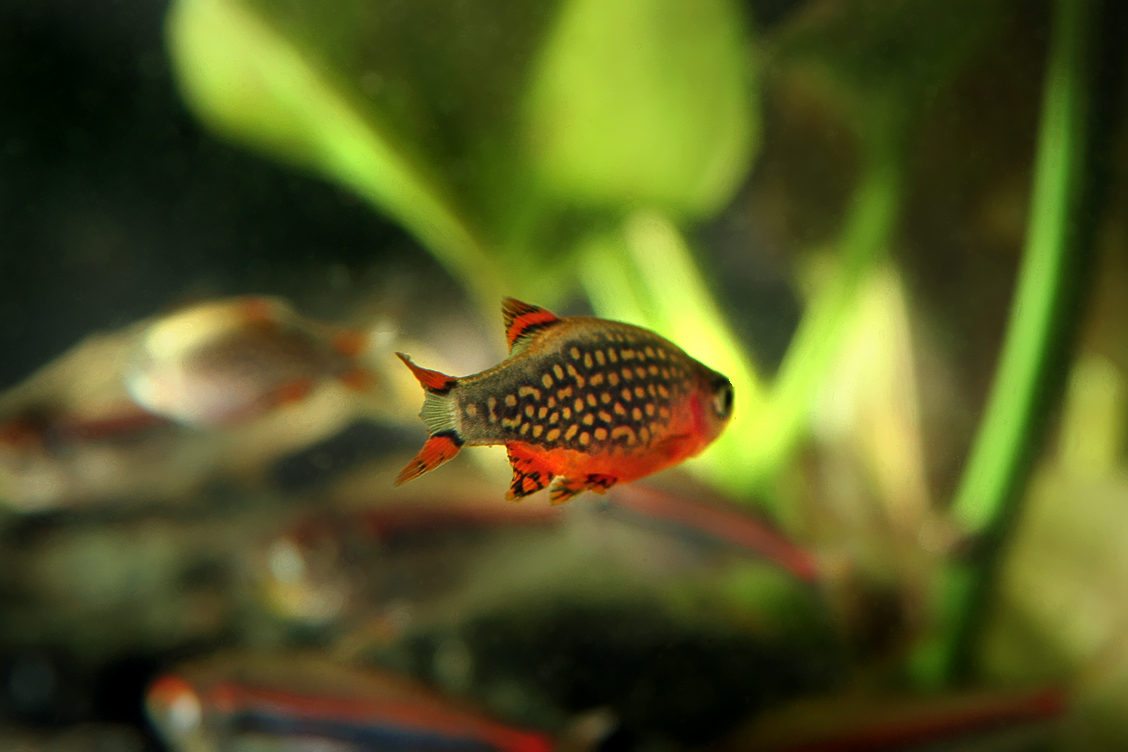Introducing the Ember Tetra, scientifically known as Hyphessobrycon amandae, a captivating little fish that’s sure to ignite your passion for freshwater aquariums. This small tetra species belongs to the Characidae family, which includes other popular aquarium favorites like neon tetras and cardinal tetras.
Table of Contents
What sets the Ember Tetra apart is its vibrant coloration. Picture this: a fiery orange-red body that seems to glow from within, contrasted by a striking black patch on its dorsal fin. It’s like having a living ember darting through your aquarium, bringing warmth and excitement to any underwater scene.
But the Ember Tetra isn’t just a pretty face. These peaceful, active fish are a delight to observe as they swim in tight schools, playfully exploring the middle and upper layers of the aquarium. They’re not picky eaters either, readily accepting a variety of foods such as flakes, small pellets, and frozen or live foods like brine shrimp and daphnia.
In their natural habitat of slow-moving streams and tributaries in Brazil, Ember Tetras thrive in slightly acidic, soft water with plenty of vegetation. They typically grow to about 0.8 inches (2 cm) in length, making them an ideal choice for smaller aquariums or as part of a larger community tank.
Interestingly, there’s a variant of the Ember Tetra known as the “Ultra Red” or “Super Red” Ember Tetra, which boasts an even more intense red coloration due to selective breeding. These little gems are highly sought after by aquarium enthusiasts looking to add an extra pop of color to their tanks.
Fun fact: Did you know that Ember Tetras are often referred to as “Red Ember Tetras” or “Fire Tetras” because of their brilliant red hue? It’s no wonder they’ve been captivating the hearts of aquarists since their discovery in the early 1900s.
So, if you’re looking for a small, colorful, and easy-to-care-for fish that will bring life and warmth to your aquarium, look no further than the enchanting Ember Tetra. With their vibrant appearance and lively personalities, these little embers are sure to spark joy in any fish enthusiast’s heart.
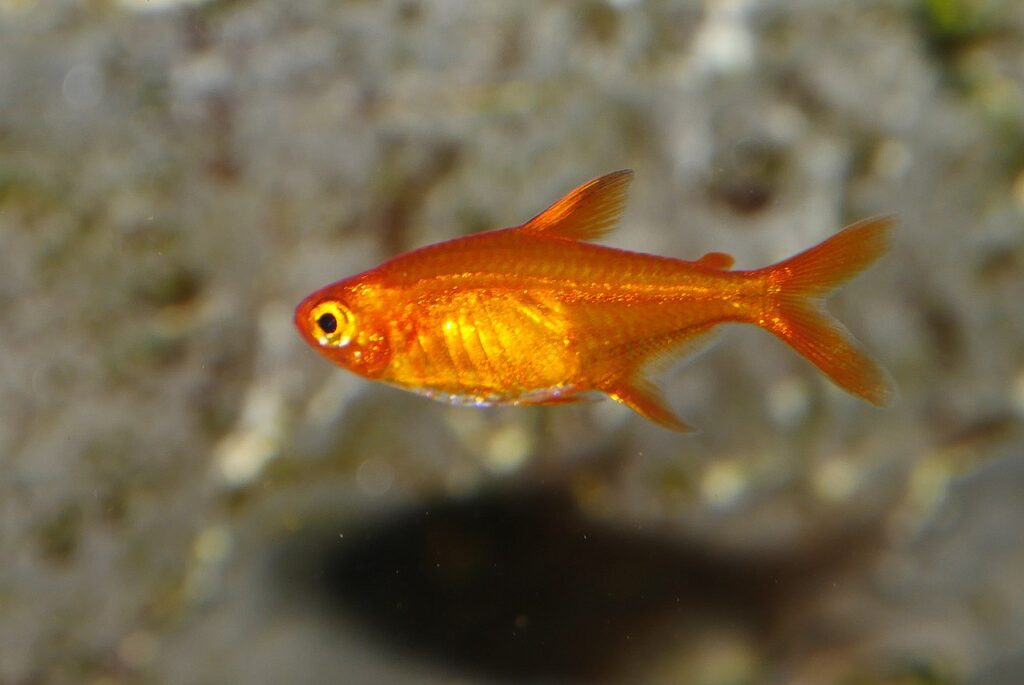
Key Information
The Ember Tetra (Hyphessobrycon amandae) is a stunning freshwater fish that comes in two main variants: the standard Ember Tetra and the “Ultra Red” or “Super Red” Ember Tetra. The latter is a selectively bred variant that boasts an even more intense red coloration, making it highly sought after by aquarium enthusiasts looking to add an extra pop of color to their tanks.
| Family | Characidae |
| Price | $2 to $5 per fish |
| Common Names | Ember Tetra, Red Ember Tetra, Fire Tetra |
| Variants | Standard Ember Tetra, Ultra Red Ember Tetra (Super Red Ember Tetra) |
| Ideal Tank Size | 10 gallons or larger |
| Water Parameters | Temperature: 68-82°F (20-28°C), pH: 5.5-7.5, Hardness: 2-15 dGH |
| Lifespan | 2-4 years |
| Full Size | 0.8 inches (2 cm) |
| Natural Environment | Slow-moving streams and tributaries in Brazil |
| Behavior | Peaceful, active, schooling fish |
| Habitat Preference | Middle and upper layers of the aquarium |
| Aquarium Decoration | Well-planted with plenty of vegetation, open swimming areas |
| Ideal Tank Mates | Other peaceful, similarly-sized fish such as neon tetras, cardinal tetras, rasboras, and small corydoras catfish |
| Fish to Avoid | Large, aggressive fish that may prey on Ember Tetras |
| Best Foods/Diet | Omnivorous; accepts flakes, small pellets, and frozen or live foods like brine shrimp and daphnia |
| Disease | Susceptible to common freshwater fish diseases if water quality is poor or stress levels are high |
| Sex-Switch | No |
| Gender Differences | Difficult to distinguish; females may be slightly larger and more rounded in the belly when carrying eggs |
| Care Level | Easy |
| Breeding Level | Moderate; spawns readily in the right conditions, but fry can be challenging to raise due to their small size |
Ideal Tank Mates
When choosing tank mates for your Ember Tetras, it’s essential to consider compatibility in terms of behavior, size, and water parameter preferences. Ember Tetras are peaceful, active schooling fish that thrive in the company of their own kind and other similarly-sized, non-aggressive species.
Ideal tank mates should not only coexist harmoniously with Ember Tetras but also contribute to creating a visually appealing and well-balanced aquarium. By selecting compatible species, you can ensure a stress-free environment where your Ember Tetras can flourish and display their natural behaviors.
Here are 15 ideal tank mates for Ember Tetras, along with reasons why they make excellent companions:
Neon Tetras
Neon Tetras are a classic choice for community tanks and make wonderful tank mates for Ember Tetras. They share similar size, behavior, and water parameter preferences, and their vibrant blue and red coloration complements the fiery hues of Ember Tetras.
Cardinal Tetras
Like Neon Tetras, Cardinal Tetras are peaceful schooling fish that can coexist harmoniously with Ember Tetras. Their striking red and blue coloration adds visual interest to the aquarium, and they occupy the same swimming levels as Ember Tetras.
Rummy Nose Tetras
Rummy Nose Tetras are active swimmers that form tight schools, making them an excellent addition to an Ember Tetra tank. They are peaceful and adaptable to a wide range of water parameters, and their unique red-tipped noses add a pop of color to the aquarium.
Harlequin Rasboras
Harlequin Rasboras are small, peaceful fish that make fantastic tank mates for Ember Tetras. They have a similar size and temperament, and their striking black and orange coloration provides a beautiful contrast to the Ember Tetras’ fiery red hues.
Cherry Barbs
Cherry Barbs are peaceful, active fish that can coexist well with Ember Tetras. They prefer similar water parameters and are known for their vibrant red coloration, which complements the Ember Tetras’ appearance.
Pygmy Corydoras
Pygmy Corydoras are tiny, peaceful bottom-dwellers that can add interest to the lower levels of your Ember Tetra tank. They are efficient scavengers, helping to keep the substrate clean, and their small size ensures they won’t outcompete the Ember Tetras for food.
Otocinclus Catfish
Otocinclus Catfish, or “Otos,” are small, peaceful algae-eaters that make excellent tank mates for Ember Tetras. They help maintain a clean aquarium by grazing on algae and are known for their gentle, non-aggressive nature.
Dwarf Gouramis
Dwarf Gouramis are peaceful, colorful fish that can add visual interest to the upper levels of your Ember Tetra tank. They are generally non-aggressive and can coexist well with smaller, peaceful species like Ember Tetras.
Endler’s Livebearers
Endler’s Livebearers are small, colorful fish that make great tank mates for Ember Tetras. They are peaceful, active swimmers that occupy the same swimming levels as Ember Tetras and can add a splash of color to your aquarium.
Kuhli Loaches
Kuhli Loaches are peaceful, eel-like bottom-dwellers that can add interest to the lower levels of your Ember Tetra tank. They are nocturnal and help keep the substrate clean by scavenging for leftover food.
Bristlenose Plecos
Bristlenose Plecos are small, peaceful algae-eaters that can help maintain a clean aquarium alongside your Ember Tetras. They are generally non-aggressive and can coexist well with smaller, peaceful species.
Mystery Snails
Mystery Snails are peaceful, algae-eating invertebrates that can add interest to your Ember Tetra tank. They help keep the aquarium clean by grazing on algae and leftover food, and their unique appearance can add visual appeal to your underwater landscape.
Red Cherry Shrimp
Red Cherry Shrimp are small, peaceful invertebrates that can make excellent tank mates for Ember Tetras. They help keep the aquarium clean by grazing on algae and leftover food, and their bright red coloration can add a pop of color to your tank.
Amano Shrimp
Amano Shrimp are larger, peaceful algae-eating shrimp that can coexist well with Ember Tetras. They are efficient scavengers and help maintain a clean aquarium by grazing on algae and leftover food.
Nerite Snails
Nerite Snails are small, peaceful algae-eaters that can help keep your Ember Tetra tank clean. They are known for their unique shell patterns and can add visual interest to your aquarium while grazing on algae.
FAQs
How many Ember Tetras should I keep together?
As schooling fish, Ember Tetras thrive in groups. It’s recommended to keep at least 6-8 Ember Tetras together to ensure they feel secure and display their natural schooling behavior. Keeping a larger group can create a more stunning visual effect in your aquarium.
Can Ember Tetras live with shrimp?
Yes, Ember Tetras can coexist peacefully with certain types of shrimp, such as Red Cherry Shrimp and Amano Shrimp. These shrimp are not only compatible with Ember Tetras but can also help keep the aquarium clean by grazing on algae and leftover food.
Are Ember Tetras sensitive to water changes?
Ember Tetras can be sensitive to sudden changes in water parameters. When performing water changes, it’s essential to ensure that the new water closely matches the existing tank water in terms of temperature, pH, and hardness to avoid stressing your Ember Tetras.
Can Ember Tetras be kept in a planted tank?
Absolutely! Ember Tetras are an excellent choice for planted aquariums. They appreciate the natural cover and hiding spots provided by aquatic plants, which can help them feel more secure and reduce stress. Plus, their vibrant coloration can really pop against a lush, green background.
How often should I feed my Ember Tetras?
It’s best to feed your Ember Tetras small amounts of food 2-3 times a day. Offering frequent, small meals helps ensure that all fish in the school have access to food and can prevent overfeeding, which can lead to water quality issues. Remember to remove any uneaten food after a few minutes to maintain a clean aquarium.
Are Ember Tetras jumpers?
While Ember Tetras are not known for being particularly prone to jumping, it’s always a good idea to keep your aquarium covered. A well-fitting lid can prevent any potential jumping incidents and also help maintain stable water parameters by reducing evaporation.
Can Ember Tetras be bred in captivity?
Yes, Ember Tetras can be bred in captivity with the right conditions. To encourage breeding, provide a separate breeding tank with slightly acidic, soft water and plenty of fine-leaved plants for the fish to scatter their eggs. Keep in mind that raising the tiny fry can be challenging and requires frequent, small feedings.

